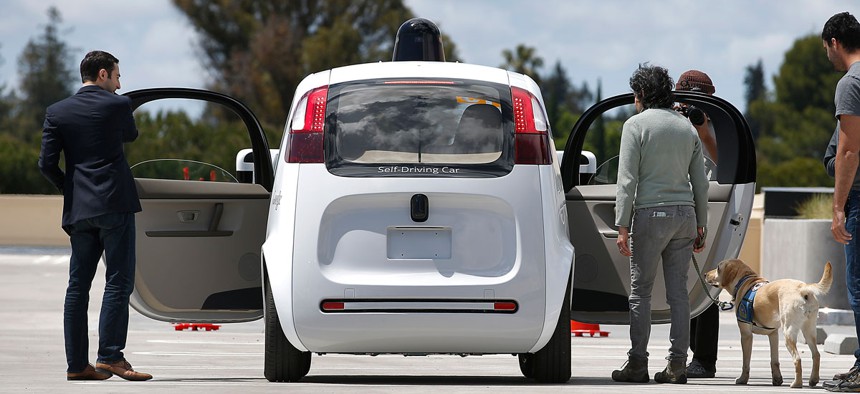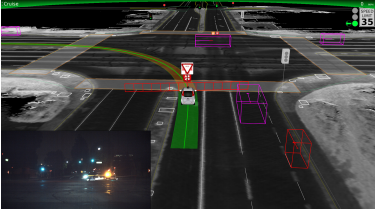When Google Self-Driving Cars Are in Accidents, Humans Are to Blame

Riders enter the Google's new self-driving prototype car for a ride during a demonstration at Google campus on Wednesday, May 13, 2015. Tony Avelar/AP
The autonomous vehicles have been in a dozen crashes since 2009, but haven’t caused any of them, the company says in a new report.
In August 2011, on one of the main roads that runs through Google’s headquarters in Mountain View, California, a Prius—one of the cars in Google’s fleet of autonomous vehicles—caused a fender-bender.
The accident happened, naturally, because there was a human behind the wheel.
That's according to a new report by Google about its self-driving car project, a document that tallies every accident since it began testing its 32 vehicles on the roads in 2009. That sounds like it could be a massive dataset, considering the tens of thousands of accidents that happen on American roadways each year. It actually isn’t: “In the six years of our project, we’ve been involved in 12 minor accidents during more than 1.8 million miles of autonomous and manual driving combined,” Google wrote. “Not once was the self-driving car the cause of the accident.”
Not once! In the case of the fender bender four summers ago, a Google employee—yes, a human—was to blame. He had borrowed the car to run a quick errand and ended up rear-ending another car. (“He was not using the vehicle to test our autonomous technology,” Google wrote, and the car ended up sustaining “some damage.”) So what ended up being probably a pretty bad day for that Google employee—imagine telling your boss you crashed the driverless car—turns out to be a tidy example of the key difference between human drivers and algorithmic ones. Namely: Robots are much, much better drivers than humans.
Google’s descriptions of the other accidents involving its self-driving cars reiterates that point. Its cars were rear-ended eight times, merged into once, and struck from the side once. One other collision that didn't cause any damage involved a non-Google car’s mirror grazing the side sensor of an automated Lexus. (One of Google’s cars was again rear-ended last week, Ars Technica reports.)
Google’s latest report, which it says will be a monthly installment, is part of a drumbeat of recent information from the tech giant about what it has learned in its experiments with self-driving cars. It has shared imagery, for instance, that shows how self-driving cars see ambulances as distinct from other kinds of traffic.

“In this example, our car was stopped at a stoplight," Google wrote. “Our light had turned green, but we detected an ambulance approaching from the right (the purple rectangle with two little red and white symbols on top), so we remained stopped as it passed through the intersection.”
Last month, Chris Urmson, the director of Google’s self-driving car program,wrote an essay for Medium outlining what he and his colleagues had learned from their work. “Not only are we developing a good understanding of minor accident rates on suburban streets, we’ve also identified patterns of driver behavior (lane-drifting, red-light running) that are leading indicators of significant collisions,” Urmson wrote. “Those behaviors don’t ever show up in official statistics, but they create dangerous situations for everyone around them.”
What has become clear, Urmson said, is that many accidents happen in intersections, that drivers make dangerous decisions when they're turning (including often going the wrong way down a street or doing something crazy to make a turn at the last minute), and that—above all— lots of people aren’t paying attention as they drive. Next-level not paying attention. “Our safety drivers routinely see people weaving in and out of their lanes,” he wrote. “We’ve spotted people reading books, and even one playing a trumpet.” (Please, dear drivers, put away your brass instruments and novels while you’re en route. Also, stop texting while driving. Seriously. Stop. Distracted driving kills thousands of people every year.)
The computer mind driving Google’s cars is far more focused on the road. It’s cautious to the point of being “jittery,” as one Mercury News reporter wrote of his Disneyland-like ride in one of the cars last month. This summer, Google's self-driving prototypes—those cute little bubble-like vehicles that look like something out of the Nintendo universe—will finally leave the test track and practice driving around Mountain View. "The new prototypes already have lots of experience to draw on," Urmson wrote in a blog post. "In fact, it’s the equivalent of about 75 years of typical American adult driving experience."
Already, Google is logging about 10,000 weekly miles of autonomous drive-time on public streets. That's the equivalent of almost two roundtrips between the Golden Gate Bridge and the U.S. Capitol every week.
“Getting these cars out into public, and allowing people to react to them, allowing us to see them out there,” Urmson said in a video about the project, “I think that's a huge deal. And most importantly, it's the necessary step to getting them to drive themselves.”
NEXT STORY: White House Wants Ideas for Open Government Plan





